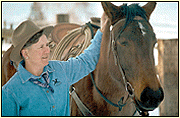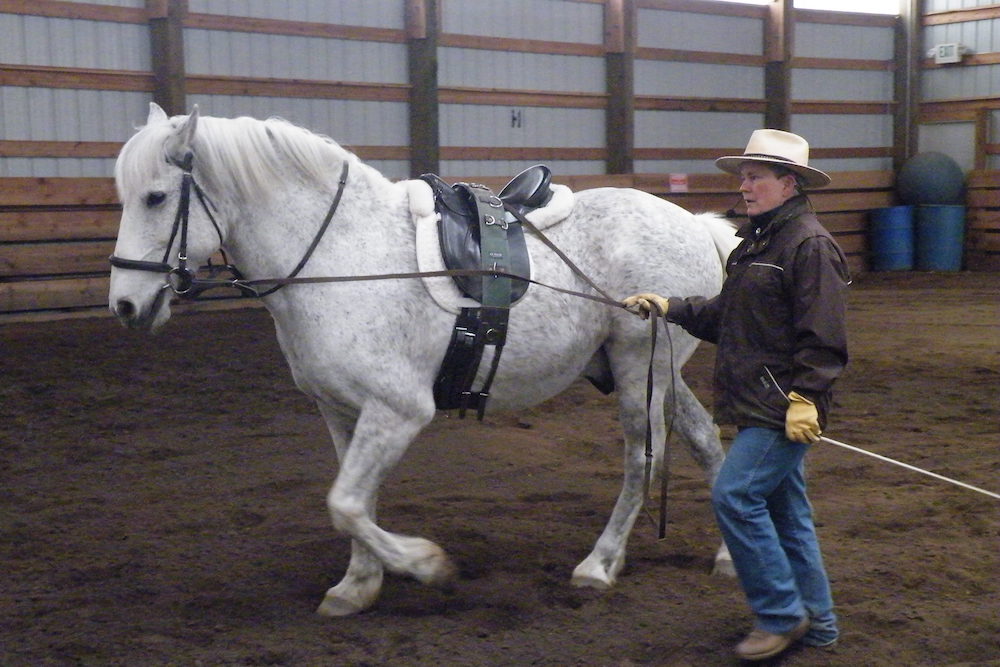Part 2 Observing Balance from the Ground
For almost all horsemanship disciplines, the master will coach us on achieving a ‘feel’ with our horse in order to accomplish specific maneuvers. Legends like Nuno Oliveira and the Dorrance brothers, tried to describe for us that elusive state in which we feel of, for and with our horse to achieve a harmonious picture. Master horsemen find a relationship in balance both mentally and physically with their equine friends. So how do we, “mere mortals,” achieve this elusive feel? I think a great start is to begin by observing how the horse moves, creating an opportunity for us to observe the bio-mechanics of balance. If we can visualize the movement, we will be one step closer to discovering how to feel it.
Begin on the ground with a series of maneuvers. It may be helpful to team-up with another horse/human team so that the humans have an opportunity to truly just watch, rather than asking your horse and trying to observe all at the same time. Another great tool is having your ground school session videoed. This way, you can dissect the movements and watch how your horse seeks balance. Most ground maneuvers can be accomplished on the lunge line, in a work-in-hand positioning, or with drive lines.

Observing Straightness
Start by simply sending your horse on a circle. Watch how the feet track up. Are the outside pair following the outside line of the imaginary railroad track and the inside pair finding the inside track? If not, what is out of alignment, particularly in the ribcage, and where is the balance in the shoulders? Are they pushing in towards you or popping out away? If only the hind feet are off the track, what is causing this displacement and how is it affecting the ability of the horse to move with rhythm?
If your horse is ‘balanced’ on a circle, the energy is created from the hindquarters, the balance moves from the back to the front, and arches level to the earth. Different gaits require different balances, particularly aft and fore. Horses naturally are more on their front end at the walk, more level at the trot, and lower in the hindquarters in a balanced canter. If we add engagement and collection to our circle, the aft and fore balance changes as the hindquarters further engage.
Observing Lateral Movements
For purposes of this discussion, let’s define lateral as moving sideways with a crossing of the feet and legs at some point during the maneuver. Therefore, a lateral movement could be a side-pass, leg yield, half-pass, or even body parts moving laterally as in the movement of the hind quarters in a forehand turn, or the crossing of the front feet in a turn on the haunch. For more—including pictures and videos of these maneuvers – check out tnthorsemanship.com.
As you observe these lateral movements, pay particular attention to how the horse positions its body to accomplish the move with a measure of rhythm and balance. Question where the energy starts from and then moves to. Pay particular attention to body parts: Do the shoulders become lighter or heavier? Does the hip lift up or drop down? How does the head and focus of the horse affect his ability to accomplish the movement? Finally, observe how these factors change with different gaits and begin to add self-carriage through practicing work-in-hand or driving on the long lines.
Give yourself the time to observe balance this month from the ground. Watch how your horse moves and seeks balance. You just don’t see them falling over very often! If we truly want to achieve feel with our horse, we need to invest time in understanding balance. Observing with integrity will help lead us to a place where horse and rider seek balance together.
Energy movement to watch for in these lateral movements:
Side-pass: The energy starts with the inside hind foot and leg, and transfers to outside foot, leg, and shoulder.
Leg yield: The movement is the same as the side pass, except there is forward progress on a diagonal line. The horse slight bend is away from the direction of travel. The balance is with the movement.
Half-pass: The energy starts with movement of the outside hind foot and transfers to the inside foot, leg, and shoulder. The horse moves forward, on the diagonal, and in the direction of the bend. Here again, the horse balances in the direction of travel.
Turn on the Haunch: The balance is heavier on the inside hind foot, and the shoulders are elevated slightly with the front feet making a reach-cross-reach motion.
Turn on the Forehand: The balance is more to the front end, with the energy moving from inside hind crossing under the belly towards the outside shoulder to seek balance on the outside hind foot.
Published June 2014 Issue

Alice was born on a ranch in eastern Oregon, the only daughter in a family of five brothers. She learned to ride behind the back of the saddle holding on to her brother’s belt loops. In the past 15 years Alice has studied with horsemen such as Tom Dorrance, Ray Hun, Dennis Reis, and Bettina Drummon. Her focus is on building a balanced relationship, applying Classical Dressage and Traditional Vaquero principles, via multi-day horsemanship retreats at her ranch in eastern OR.






